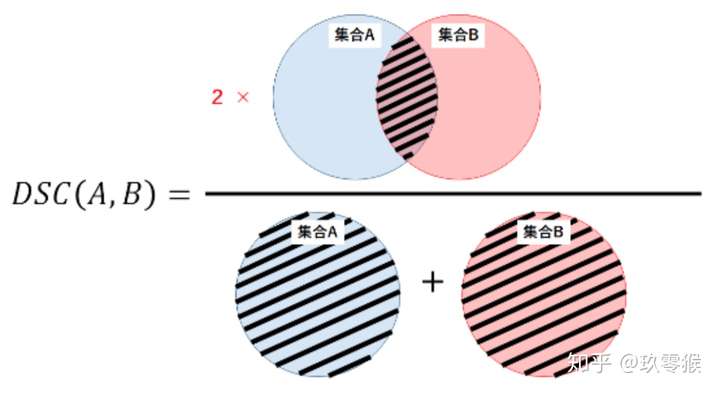分割常用评价指标及代码
分割常用评价指标及代码
来源:知乎
来源标题:分割常用评价指标及代码
来源链接:https://zhuanlan.zhihu.com/p/117435908?from_voters_page=true
著作权归作者所有。商业转载请联系作者获得授权,非商业转载请注明出处。
Dice
对于分割过程中的评价标准主要采用Dice相似系数(Dice Similariy Coefficient,DSC),Dice系数是一种集合相似度度量指标,通常用于计算两个样本的相似度,值的范围 ,分割结果最好时值为
,最差时值为

copydef dice_coef(output, target):#output为预测结果 target为真实结果
smooth = 1e-5 #防止0除
if torch.is_tensor(output):
output = torch.sigmoid(output).data.cpu().numpy()
if torch.is_tensor(target):
target = target.data.cpu().numpy()
intersection = (output * target).sum()
return (2. * intersection + smooth) / \
(output.sum() + target.sum() + smooth)
IOU
copydef iou_score(output, target):
smooth = 1e-5
if torch.is_tensor(output):
output = torch.sigmoid(output).data.cpu().numpy()
if torch.is_tensor(target):
target = target.data.cpu().numpy()
output_ = output > 0.5
target_ = target > 0.5
intersection = (output_ & target_).sum()
union = (output_ | target_).sum()
return (intersection + smooth) / (union + smooth)
Sensitivity
copydef sensitivity(output, target):
smooth = 1e-5
if torch.is_tensor(output):
output = torch.sigmoid(output).data.cpu().numpy()
if torch.is_tensor(target):
target = target.data.cpu().numpy()
intersection = (output * target).sum()
return (intersection + smooth) / (target.sum() + smooth)
PPV
copydef ppv(output, target):
smooth = 1e-5
if torch.is_tensor(output):
output = torch.sigmoid(output).data.cpu().numpy()
if torch.is_tensor(target):
target = target.data.cpu().numpy()
intersection = (output * target).sum()
return (intersection + smooth) / (output.sum() + smooth)
Hausdorff_95 (95% HD)
Dice对mask的内部填充比较敏感,而hausdorff distance 对分割出的边界比较敏感。
Hausdorff_95就是是最后的值乘以95%,目的是为了消除离群值的一个非常小的子集的影响。
- 环境安装
copypip install -i https://pypi.tuna.tsinghua.edu.cn/simple numba pip install hausdorff
copyimport numpy as np
from hausdorff import hausdorff_distance
# two random 2D arrays (second dimension must match)
np.random.seed(0)
X = np.random.random((1000,100))
Y = np.random.random((5000,100))
# Test computation of Hausdorff distance with different base distances
print("Hausdorff distance test: {0}".format( hausdorff_distance(X, Y, distance="manhattan") ))
print("Hausdorff distance test: {0}".format( hausdorff_distance(X, Y, distance="euclidean") ))
print("Hausdorff distance test: {0}".format( hausdorff_distance(X, Y, distance="chebyshev") ))
print("Hausdorff distance test: {0}".format( hausdorff_distance(X, Y, distance="cosine") ))
# For haversine, use 2D lat, lng coordinates
def rand_lat_lng(N):
lats = np.random.uniform(-90, 90, N)
lngs = np.random.uniform(-180, 180, N)
return np.stack([lats, lngs], axis=-1)
X = rand_lat_lng(100)
Y = rand_lat_lng(250)
print("Hausdorff haversine test: {0}".format( hausdorff_distance(X, Y, distance="haversine") ))




【推荐】国内首个AI IDE,深度理解中文开发场景,立即下载体验Trae
【推荐】编程新体验,更懂你的AI,立即体验豆包MarsCode编程助手
【推荐】抖音旗下AI助手豆包,你的智能百科全书,全免费不限次数
【推荐】轻量又高性能的 SSH 工具 IShell:AI 加持,快人一步